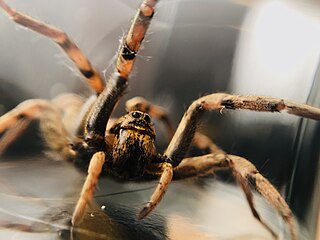
Wolf spiders are members of the family Lycosidae, from the Ancient Greek word "λύκος" meaning "wolf". They are robust and agile hunters with excellent eyesight. They live mostly in solitude and hunt alone, and do not spin webs. Some are opportunistic hunters pouncing upon prey as they find it or even chasing it over short distances. Some wait for passing prey in or near the mouth of a burrow.

The sac spiders of the family Clubionidae have a very confusing taxonomic history. Once, this family was a large catch-all taxon for a disparate collection of spiders, similar only in that they had eight eyes arranged in two rows and conical anterior spinnerets that touched, and were wandering predators that built silken retreats, or sacs, usually on plant terminals, between leaves, under bark, or under rocks. These are now recognized to include several families, some of which are more closely related to the three-clawed spiders, like lynx and wolf spiders, than to Clubionidae and related families.

Ant spiders are members of the family Zodariidae. They are small to medium-sized eight-eyed spiders found in all tropical and subtropical regions of South America, Africa, Madagascar, Australia-New Guinea, New Zealand, Arabia and the Indian subcontinent. Most species are daytime hunters and live together with ants, mimicking their behavior and sometimes even their chemical traits. Although little is known about most zodariids, members of the genus Zodarion apparently feed only on ants; a number of other genera in the family are apparently also ant specialists.

Corinnidae is a family of araneomorph spiders, sometimes called corinnid sac spiders. The family, like other "clubionoid" families, has a confusing taxonomic history. Once it was a part of the large catch-all taxon Clubionidae, now very much smaller. The original members of the family are apparently similar only in that they have eight eyes arranged in two rows, conical anterior spinnerets that touch and are generally wandering predators that build silken retreats, or sacs, usually on plant terminals, between leaves, under bark or under rocks.

Zoropsidae, also known as false wolf spiders for their physical similarity to wolf spiders, is a family of cribellate araneomorph spiders first described by Philipp Bertkau in 1882. They can be distinguished from wolf spiders by their two rows of eyes that are more equal in size than those of Lycosidae.

Aelurillus is a genus of spiders in the family Salticidae.
Pachyonomastus is a monotypic genus of East African jumping spiders containing the single species, Pachyonomastus kittenbergeri. It was first described by Lodovico di Caporiacco in 1947, and is only found in Africa. The name is a combination of the Ancient Greek παχύς ("pachys"), meaning "thick", and the related genus Onomastus. The species is named in honor of Kálmán Kittenberger, who collected the species.
Pseudoplexippus is a monotypic genus of Tanzanian jumping spiders containing the single species, Pseudoplexippus unicus. It was first described by Lodovico di Caporiacco in 1947, and is found only in Tanzania. The name is a combination of the Ancient Greek "pseudo-" (ψευδής), meaning "false", and the salticid genus Plexippus.

Gallieniellidae is a family of spiders first described by J. Millot in 1947. It was originally thought to be endemic to Madagascar until species were also found in southern Kenya, northeastern Argentina, and Australia. Drassodella was transferred from the family Gnaphosidae in 1990. They are suspected to be specialized in ant-preying.
Orthobula is a genus of araneomorph spiders first described by Eugène Simon in 1897 as a member of Liocranidae. It was transferred to Corinnidae in 2002, to Phrurolithidae in 2014, and to Trachelidae in 2017.
Benoitia is a genus of funnel weavers first described by Pekka T. Lehtinen in 1967.
Mistaria is a genus of funnel weavers first described by Pekka T. Lehtinen in 1967.
Scorteccia is a monotypic genus of North African corinnid sac spiders containing the single species, Scorteccia termitarum. It was first described by Lodovico di Caporiacco in 1936, and has only been found in Libya.
Hoplolathys is a monotypic genus of East African cribellate araneomorph spiders in the family Dictynidae containing the single species, Hoplolathys aethiopica. It was first described by Lodovico di Caporiacco in 1947, and has only been found in Ethiopia.
Synotaxus is a genus of araneomorph spiders in the family Synotaxidae that was first described by Eugène Louis Simon in 1895. Originally placed with the tangle web spiders, it was moved to the Synotaxidae in 2017.
Nemosinga is a genus of East African orb-weaver spiders first described by Lodovico di Caporiacco in 1947. As of April 2019 it contains only three species, all found in Tanzania.
Toschia is a genus of sheet weavers that was first described by Lodovico di Caporiacco in 1949.

Asceua is a genus of Asian ant spiders first described by Tamerlan Thorell in 1887.

Acanthinozodium is a genus of spiders in the family Zodariidae. It was described in 1966 by Jacques Denis. As of 2017, it contains 12 species, all found in Africa.
Aelurillus subaffinis is a jumping spider species in the genus Aelurillus. The female was first described in 1947 by Ludovico di Caporiacco.








